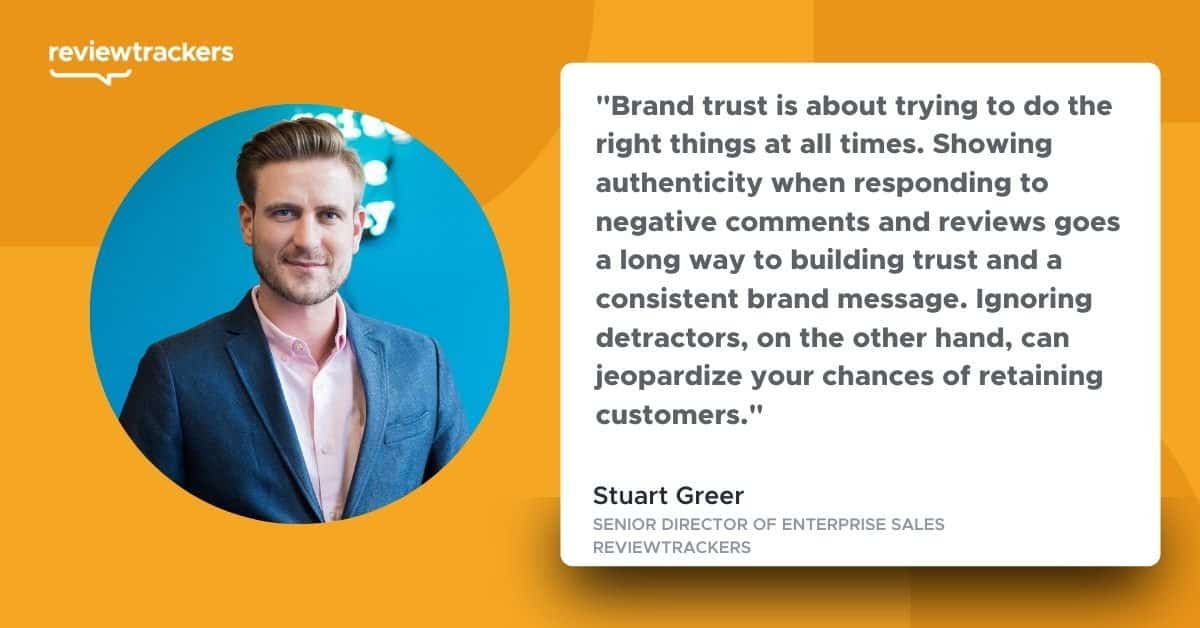Brand trust is one of the most important factors in consumers’ purchase decisions. Specifically, more than one in three (35%) consumers ranked “trust in the brand” as among their top three reasons for choosing a retailer.
But brand trust is earned, not given, and businesses still have a long way to go in gaining significant backing from customers. According to Edelman, only 48% of the population in the U.S. trust businesses as an institution. To build trust and retain customers, brands should try a combination of the following methods:
- Engage with customers on their preferred channels
- Manage online reviews and ratings
- Harness user-generated content
- Deliver a great customer experience
- Stay authentic
Ways to Build Brand Trust
Building brand trust takes a lot of work and planning, and there are multiple factors that determine if your brand successfully determines consumers’ trust. When utilized effectively, the methods below help you achieve competitive differentiation and inspire customer loyalty.

Engage with Customers on their Preferred Channels
Modern consumers prefer to do their own research before making a purchase decision. Instead of looking at advertising and marketing communications, they turn to their family and friends for recommendations, listen to influencers on social media, and rely on business review sites.
These are platforms consumers use on a daily basis; so join them and engage in conversation, but do so from a tone of authenticity. Don’t barrage them with sales pitches, marketing lingo, and “key benefits.” Instead answer questions, know how to respond to negative reviews, and connect via social media comments. You can also further strengthen your brand’s authenticity by claiming local listings and business directories, which provide helpful information across your digital properties.
Manage Online Reviews and Ratings
Online reviews have a direct impact on your brand reputation and your ability to build brand trust.
According to the latest Online Reviews Survey, negative reviews drive away customers, with 94% saying that an online review has convinced them to avoid a business. Customers don’t particularly trust businesses with lower than 4-star ratings and 80% of consumers say the star ratings they trust the most are 4.0, 4.5, and 5 stars.
When customers take the time to share their thoughts and experiences in a review, the best thing to do is to learn how to respond to negative reviews in addition to raving feedback. Reviews — both good and bad — create unique opportunities for inspiring brand trust in consumers who use multiple channels to discover and evaluate products and services.
Harness User-Generated Content
User-generated content (UGC) refers to original content created and made publicly available by individuals outside your organization or brand. You can use UGC as a way to build brand trust, and it can be far more effective than traditional techniques and tactics like paid advertising, PR blitzes, and invasive sales messages and promotions.

UGC works because consumers are more proactive and research-driven and seek social proof. They’re also more eager than ever to validate their purchase decisions by searching for information online through social media and review sites, and UGC plays a major role.
Common examples of UGC include:
- Online reviews and ratings of your business on sites like Yelp, Google, and Tripadvisor
- Reviews aggregated or embedded on your site via a review widget
- “Tips” left by Foursquare users who checked into your location
- Customer testimonials and success stories
- Video reviews of your product or service posted on YouTube, Instagram photos, videos, and stories that tagged your business
Check out these examples of user-generated content to develop your brand and boost your marketing performance.
Deliver a Great Customer Experience
According to research by Oracle, approximately 82% of consumers have had a disappointing or upsetting experience with a brand in the past. Over half of this number (43%) say they blacklist brands that fail to meet their expectations. However, all is not lost.
Despite the odds, brands can still climb back and find ways to improve the customer experience. By listening to customer feedback and reviews, you can find insights to better understand their wants and needs. Acting on this valuable data can bring more returns and customer retention in the long run.

Combing through a plethora of reviews to find these insights can be a daunting task, but there are some worthwhile customer experience analytics software available that use AI and machine learning to make the process quick and easy.
Stay Authentic
Consumers won’t trust your brand if it doesn’t seem authentic. “Real and organic” is better than “perfect and packaged,” and authenticity has proven to be at the heart of brand trustworthiness.
Case in point: according to Northwestern University research, product purchases are most influenced by reviews with an average rating of 4.2 to 4.5 stars out of 5 — making this the ideal average star rating for purchase probability.
In other words, your brand doesn’t have to be perfect for it to be trustworthy, but it has to possess relatable qualities to consumers. Take time to share the content that demonstrates your brand goals, culture, and values that set you apart. Take it one step further by embracing negative feedback, and invite your customers to share their stories. Just be sure to meet consumers halfway by responding openly and honestly to queries on social media and online reviews.
At a time when consumers value authenticity more than perfection, your brand should do the same.

The Importance of Brand Trust
Building brand trust is an important competitive differentiator, but it doesn’t happen in a vacuum. You have to close the gap between customer expectations and the actual experience by actively managing your online reputation, listening to the voice of the customer, and developing authentic relationships.
If you make the commitment and apply best practices, consumers will choose you over competitors and stay with you for the long haul.